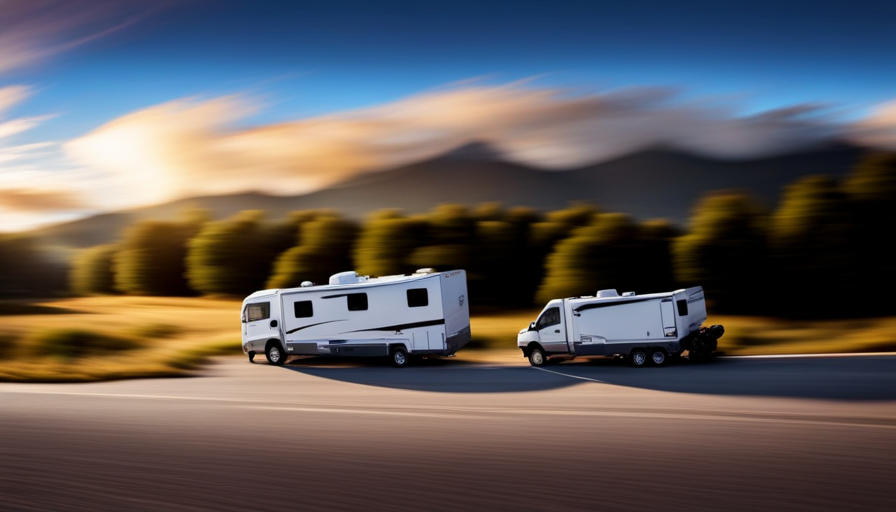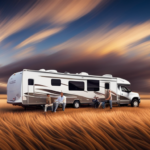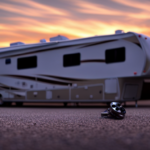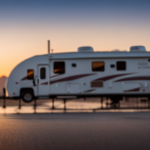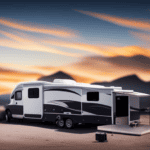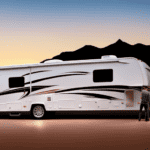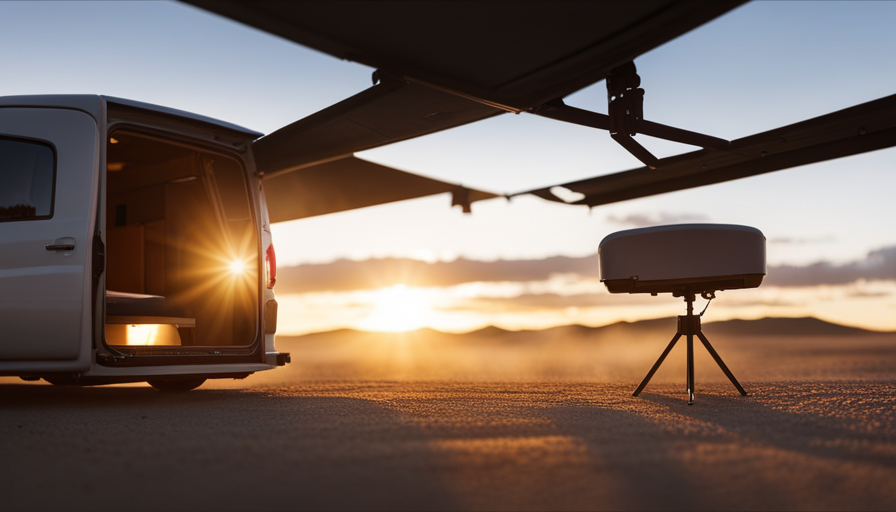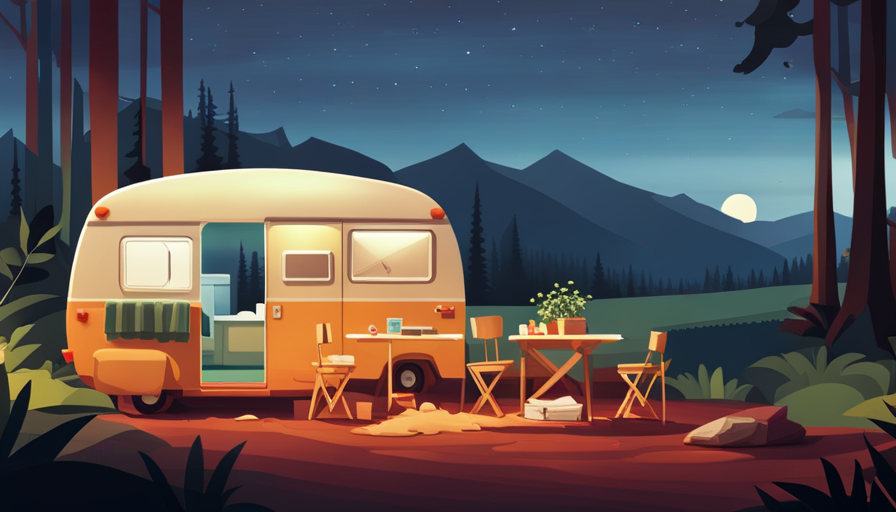Imagine this situation: you’re behind the wheel of your truck, with the wide open road stretching out in front of you, and attached to your vehicle is your trusty 5th wheel camper, ready for adventure. Transporting a 5th wheel camper may seem daunting at first, but with the right knowledge and preparations, it can become a smooth and enjoyable journey.
In this article, I will guide you through the process of moving a 5th wheel camper, from conducting a pre-trip inspection to practicing safe driving techniques. We’ll cover everything you need to know to ensure a successful journey, including hitching and towing setup, route planning, maintenance checks, and RV parking techniques.
But before we dive into the specifics, let me share a little metaphor with you. Moving a 5th wheel camper is like embarking on a journey of self-discovery. It’s about embracing the freedom of the open road, exploring new destinations, and creating lifelong memories.
So, grab your keys, buckle up, and let’s hit the road together!
Key Takeaways
- Conduct a pre-trip inspection to ensure a smooth and safe journey
- Properly hitch and tow the camper for secure transportation
- Practice safe driving techniques when towing, including adjusting speed and following distance
- Maintain regular maintenance checks and secure loose items inside the camper for a hassle-free trip
Conduct a Pre-Trip Inspection
Before hitting the road with your 5th wheel camper, make sure to do a pre-trip inspection to avoid any unexpected surprises along the way.
Checking tire pressure is crucial for a safe and smooth journey. Improperly inflated tires can lead to blowouts, decreased fuel efficiency, and difficulty in handling the camper. Use a tire pressure gauge to measure the pressure in each tire, including the spare, and ensure they’re inflated to the manufacturer’s recommended levels.
Next, it’s essential to inspect the brakes thoroughly. Faulty brakes can cause accidents and put you and your camper at risk. Start by examining the brake pads and rotors for any signs of wear and tear. Replace them if necessary. Additionally, check the brake fluid level and top it up if needed. Test the brakes by engaging them while driving at a slow speed to ensure they’re responsive and functioning correctly.
By performing a comprehensive pre-trip inspection, including checking tire pressure and inspecting brakes, you can ensure a safer and more enjoyable journey with your 5th wheel camper.
Now that we’ve covered the importance of conducting a pre-trip inspection, let’s move on to the next section about ensuring proper hitching and towing setup.
Ensure Proper Hitching and Towing Setup
To ensure a proper hitching and towing setup, it’s essential to double-check that all safety chains are securely attached before hitting the road. For instance, imagine a scenario where a camper’s safety chains were not properly connected, resulting in the trailer becoming unhitched while driving, causing a dangerous situation for both the driver and other motorists.
When it comes to hitching techniques, it’s important to ensure that the hitch is properly aligned with the trailer’s kingpin. This can be done by adjusting the height of the hitch and using a spotter to guide you. Once the hitch is aligned, lower it onto the kingpin and secure it with the locking mechanism.
Weight distribution is another crucial aspect of a proper setup. Uneven weight distribution can lead to stability issues and poor handling. To achieve proper weight distribution, use a weight distribution hitch that evenly distributes the weight between the camper and the towing vehicle. This will help maintain control and stability while on the road.
In order to evoke emotion in the audience, let’s take a look at the following table:
| Hitching Techniques | Weight Distribution |
|---|---|
| Proper alignment | Even weight distribution |
| Spotter assistance | Weight distribution hitch |
| Locking mechanism | Control and stability |
By following these hitching techniques and ensuring proper weight distribution, you can have a safer and more enjoyable towing experience. Next, let’s discuss how to plan your route and check for restrictions to avoid any unnecessary challenges along the way.
Plan Your Route and Check for Restrictions
Mapping out your journey and checking for any road restrictions or obstacles can help ensure a smooth and hassle-free towing experience. When it comes to moving a 5th wheel camper, planning your route and being aware of any potential restrictions is crucial. Here are four important things to consider:
-
Plan your fuel stops: Take note of gas stations or truck stops along your route that can accommodate your vehicle and camper. It’s important to have enough fuel to reach your destination without any issues.
-
Consider weather conditions: Check the weather forecast for your entire route, including any potential storms or extreme conditions. This will help you prepare and make necessary adjustments to your travel plans if needed.
-
Research road restrictions: Some roads have weight or height restrictions that may not be suitable for towing a 5th wheel camper. Make sure to research and plan alternate routes if necessary to avoid any complications.
-
Be mindful of traffic and construction: Check for any ongoing road construction or heavy traffic areas along your route. Planning ahead can help you avoid delays and find alternative routes if needed.
Mapping out your journey and being aware of potential road restrictions, weather conditions, and other factors will ensure a smoother towing experience. Once you’ve planned your route and considered all these factors, it’s time to focus on practicing safe driving techniques.
Practice Safe Driving Techniques
When it comes to towing a 5th wheel camper, it’s crucial to adjust your driving habits for the added weight and size.
This means being aware of your speed, braking distance, and acceleration. Additionally, using extra caution on turns and hills is essential to prevent accidents and ensure a smooth ride.
Lastly, maintaining a safe following distance is important to allow for ample reaction time and avoid collisions.
By practicing these safe driving techniques, you can confidently navigate the roads with your 5th wheel camper.
Adjust Your Driving Habits for Towing
Changing your driving habits when towing a 5th wheel camper can make all the difference in ensuring a safe and smooth journey. Here are some important tips to keep in mind:
-
Adjusting Speed: When towing, it’s crucial to reduce your speed. The added weight of the camper affects your vehicle’s handling and braking abilities, so driving slower gives you more time to react to unexpected situations.
-
Braking Techniques: Be mindful of your braking distance when towing. Start applying the brakes earlier than usual and give yourself plenty of room to stop. Avoid sudden or hard braking, as it can cause the camper to sway or jackknife.
-
Maintain a safe following distance: Leave more space between your vehicle and the one ahead. This allows for better visibility and gives you more time to react if the vehicle in front suddenly stops.
-
Stay in the right lane: Stick to the right lane whenever possible, especially on highways. This allows faster-moving vehicles to pass safely and reduces the chances of getting caught in the blind spot of larger trucks.
By adjusting your driving habits to accommodate towing, you can ensure a safe and enjoyable journey.
As we move on to the next section about using extra caution on turns and hills, it’s important to remember that these tips are just the beginning of a comprehensive guide for towing a 5th wheel camper.
Use Extra Caution on Turns and Hills
Navigating turns and hills while towing a 5th wheel camper requires extra caution to ensure a smooth and safe journey. When it comes to turns, it’s important to take them slowly and wide, giving yourself plenty of room to maneuver. Be mindful of the length and width of your camper, as it may require a wider turning radius than you’re used to.
Additionally, extra caution should be exercised when encountering hills. Ascending hills can put strain on your vehicle, so be sure to maintain a steady speed and shift to a lower gear if needed. Descending hills require controlled braking to prevent the camper from gaining too much momentum. On gravel roads, it’s crucial to reduce speed even further to maintain traction.
Navigating narrow spaces may require assistance from a spotter or using mirrors to ensure clearance. Lastly, maintaining a safe following distance is essential for the safety of both you and other drivers, allowing you ample time to react to any sudden changes in traffic.
Transitioning into the next section, let’s discuss how to maintain a safe following distance without compromising on efficiency.
Maintain a Safe Following Distance
Ensuring a safe distance between vehicles is crucial for protecting yourself and others on the road. When towing a 5th wheel camper, maintaining a safe following distance becomes even more important. It allows you to have enough time to react to sudden stops or any potential hazards that may arise. To emphasize the significance of maintaining a safe distance, consider the following table:
| Distance (in feet) | Speed (in mph) | Recommended Safe Following Distance |
|---|---|---|
| 30 | 30 | 6 |
| 40 | 40 | 8 |
| 50 | 50 | 10 |
| 60 | 60 | 12 |
To further ensure your safety, always maintain the correct tire pressure and regularly check the functionality of your brakes. By doing so, you can prevent potential accidents and maintain control over your vehicle. Moving forward, let’s discuss the importance of performing regular maintenance checks to keep your 5th wheel camper in top condition.
Perform Regular Maintenance Checks
Performing regular maintenance checks on your 5th wheel camper will help you avoid unexpected breakdowns and ensure a worry-free journey. It’s crucial to establish a regular maintenance schedule to keep your camper in top condition.
Regularly inspecting vital components such as the tires, brakes, and suspension system can help identify any potential issues before they escalate into major problems. Additionally, checking the camper’s electrical system, plumbing, and propane tanks is essential to ensure they’re functioning correctly.
Common maintenance issues that may arise include tire wear, brake problems, and suspension issues. Tire wear can be easily prevented by regularly checking the tire pressure and ensuring they’re properly inflated. Brake problems can arise due to worn brake pads or damaged brake lines, so it’s important to inspect them regularly and replace any faulty parts. Suspension issues, such as worn-out shocks or springs, can affect the stability and handling of the camper, so they should be inspected and replaced as necessary.
By proactively addressing these maintenance tasks, you can minimize the risk of unexpected breakdowns and costly repairs during your travels.
In the next section, we’ll discuss how to secure loose items inside the camper, ensuring a safe and comfortable journey.
Secure Loose Items Inside the Camper
To prevent a chaotic mess resembling a tornado aftermath, it’s essential to strap down loose items inside your rolling living quarters. When towing a 5th wheel camper, it’s important to secure storage items to prevent damage and ensure a safe journey.
Before hitting the road, take the time to evaluate the inside of your camper. Start by securing larger items such as chairs, tables, and appliances. Use bungee cords or cargo nets to fasten these items to solid anchor points, preventing them from shifting during transit.
For smaller items like kitchen utensils, books, and electronics, consider using storage containers or organizers to keep them in place. Make sure to secure these containers to prevent them from sliding or falling over.
Additionally, inspect all cabinets and drawers to ensure they’re properly latched and won’t open during travel. By taking these precautions, you can prevent damage to your belongings and avoid any potential accidents caused by flying objects.
Now, with all loose items safely secured, we can move on to the next step: utilizing proper RV parking and setup techniques.
Utilize Proper RV Parking and Setup Techniques
When parking and setting up my RV, it’s crucial to level the camper properly to ensure stability and prevent any issues with doors or appliances.
I always make sure to use leveling blocks or ramps to achieve a level surface.
Next, I connect the camper to utilities such as electricity and water, making sure to follow safety guidelines and properly secure all connections.
Lastly, I stabilize the camper by using stabilizer jacks or wheel chocks to minimize any movement or sway, ensuring a comfortable and safe experience inside the RV.
Leveling the Camper
Leveling the camper is essential for a smooth and comfortable camping experience, making sure that everything stays in its place without any unexpected surprises.
Here are three important leveling techniques to ensure your camper is properly leveled:
-
Use a bubble level: Place a bubble level on the floor of your camper and adjust the leveling jacks until the bubble is centered. This will ensure that your camper is level from side to side.
-
Utilize leveling blocks: If your campsite is uneven, use leveling blocks to raise the low side of your camper. These blocks can be stacked and positioned under the wheels to achieve the desired level.
-
Invest in a leveling system: Consider purchasing a leveling system for your camper. These systems are designed to automatically level your camper with just the push of a button, making the process quick and hassle-free.
By properly leveling your camper, you’ll create a stable and comfortable living space.
Now, let’s move on to setting up utilities (electricity, water, etc.) for a seamless camping experience.
Setting Up Utilities (Electricity, Water, etc.)
Now that the camper is level, it’s time to set up the utilities such as electricity and water. When it comes to electricity, safety should always be a top priority. Make sure to check the campground’s electrical hookup for any damage or issues before connecting your camper. Use a surge protector to safeguard your camper’s electrical system from power surges. Additionally, consider using LED lights inside your camper to conserve energy. When it comes to water, it’s important to be mindful of conservation. Use low-flow faucets and showerheads to minimize water usage. Consider reusing graywater for tasks such as flushing toilets or watering plants. To grab your attention and provide a quick summary, here’s a helpful table:
| Electricity Safety Tips | Water Conservation Tips |
|---|---|
| Check electrical hookup for damage | Use low-flow faucets and showerheads |
| Use a surge protector | Reuse graywater for tasks |
| Consider using LED lights |
By following these tips, you can ensure a safe and efficient setup of utilities for your camper. Now, let’s move on to stabilizing the camper for ultimate comfort.
Stabilizing the Camper for Comfort
To create a solid foundation for a cozy and secure experience, it’s essential to ensure the camper is firmly grounded. Camper stability is crucial for a comfortable stay, and leveling techniques play a significant role in achieving this.
Start by parking the camper on a level surface, using a bubble level to check for any unevenness. Once parked, utilize leveling blocks or jacks to adjust the height of the camper’s tires, ensuring it sits evenly.
To further stabilize the camper, utilize stabilizer jacks at each corner, extending them until they firmly touch the ground. This will minimize any rocking or swaying while inside. Additionally, consider using stabilizer bars or wheel chocks for added stability.
By employing these techniques, you can enjoy a more comfortable and secure camping experience.
Now, let’s discuss how to stay alert and prepared for emergencies.
Stay Alert and Prepared for Emergencies
Always be vigilant and ready for any unforeseen emergencies that may arise while you’re towing your 5th wheel camper. It’s crucial to stay calm and handle emergencies efficiently to ensure the safety of yourself and others on the road.
One of the most important aspects of emergency preparedness is staying alert and aware of your surroundings at all times. Keep an eye out for any potential hazards or dangers on the road, such as sudden traffic changes, weather conditions, or road obstacles. Additionally, make sure you have a well-stocked emergency kit that includes essential items like a first aid kit, flashlight, extra batteries, and tools for minor repairs.
In case of an emergency, it’s important to know how to react appropriately. Stay calm and assess the situation before taking any action. If it’s safe to do so, move your camper to a secure location away from traffic. If necessary, contact emergency services for assistance. Remember to always prioritize your safety and the safety of others.
By following these safety measures and being prepared for emergencies, you can ensure a smoother and safer towing experience.
Next, let’s discuss how to follow campground etiquette and regulations, ensuring a pleasant stay for everyone involved.
Follow Campground Etiquette and Regulations
Following campground etiquette and regulations is essential for creating a harmonious and enjoyable experience for all campers involved, ensuring that everyone can relax and have a great time.
When it comes to campground etiquette, noise control is of utmost importance. Be mindful of quiet hours and keep noise levels to a minimum, especially during the evening and early morning hours.
Additionally, familiarize yourself with the pet policies at the campground. Always clean up after your pets and keep them on a leash to ensure the safety and comfort of all campers.
In terms of regulations, fire safety should be a top priority. Follow the campground’s guidelines for building and extinguishing fires, and never leave a fire unattended.
Additionally, adhere to the posted speed limits within the campground to ensure the safety of pedestrians and other vehicles. Speeding can be dangerous and disrupt the peaceful atmosphere of the campground.
By respecting campground etiquette and following regulations, you can contribute to a positive camping experience for everyone.
So, as you embark on your next adventure and explore new destinations, remember to be mindful of these guidelines and enjoy the beauty of the great outdoors!
Enjoy Your Adventure and Explore New Destinations!
Enjoy your adventure and explore new destinations!
Discover new horizons and embark on an unforgettable adventure as you explore breathtaking destinations! Moving a 5th wheel camper opens up a world of possibilities for exploring new places and creating lasting memories. As you hit the road, here are some adventure tips and destination recommendations to enhance your experience.
Firstly, make sure to plan your route ahead of time and research potential destinations along the way. Look for campgrounds or RV parks that offer amenities and activities that align with your interests. Whether you enjoy hiking, fishing, or simply relaxing by the campfire, there are countless destinations to suit your preferences.
When choosing a new destination, consider the season and weather conditions. Some areas are more enjoyable during specific times of the year, so be sure to check for any potential road closures or weather-related restrictions. Additionally, don’t be afraid to explore off-the-beaten-path locations. These hidden gems often offer a quieter and more serene camping experience.
As you venture to new destinations, take the time to immerse yourself in the local culture and attractions. Visit nearby landmarks, try local cuisine, and engage with the community. This will not only enrich your adventure but also create lasting memories.
So, pack your sense of adventure and get ready to explore new horizons with your 5th wheel camper. With these adventure tips and destination recommendations, you’re sure to have an incredible journey filled with unforgettable experiences. Happy travels!
Frequently Asked Questions
What are some common mistakes to avoid when moving a 5th wheel camper?
When it comes to moving a 5th wheel camper, there are a few common mistakes that people often make. One of the biggest mistakes is not properly securing the camper before hitting the road. This can lead to accidents or damage to the camper.
Another mistake is not checking the weight distribution, which can result in poor handling and instability.
It’s also important to be cautious while turning and backing up, as these maneuvers can be tricky with a 5th wheel camper.
How do I choose the right towing vehicle for my 5th wheel camper?
Choosing the right towing vehicle for your 5th wheel camper requires careful consideration of towing capacity. To tackle this task, start by assessing the weight of your camper and ensuring your chosen vehicle has a sufficient towing capacity.
Additionally, factor in the payload capacity, engine power, and braking system of the vehicle. Don’t forget to consult the manufacturer’s guidelines and seek professional advice if needed.
Making an informed decision will ensure a safe and enjoyable towing experience.
Are there any special precautions to take when driving on steep or uneven terrain with a 5th wheel camper?
When driving on steep or uneven terrain with a 5th wheel camper, it’s important to use proper driving techniques and ensure proper weight distribution.
Take it slow and steady, maintaining a consistent speed and avoiding sudden acceleration or braking. Keep an eye on the road ahead to anticipate any potential obstacles or changes in terrain.
Additionally, make sure the weight of the camper is evenly distributed to prevent imbalance and maintain stability while driving.
How often should I inspect and replace the tires on my 5th wheel camper?
I inspect and replace the tires on my 5th wheel camper regularly to ensure safe travels. To determine when to replace them, I follow a simple rule: every six years or 10,000 miles, whichever comes first.
To inspect the tires, I check for signs of wear, such as uneven tread or cracking. I also measure the tire pressure and ensure it matches the manufacturer’s recommendations. Taking these steps helps me maintain the longevity and reliability of my camper’s tires.
What should I do if my 5th wheel camper experiences a mechanical issue while on the road?
If my 5th wheel camper experiences a mechanical issue while on the road, dealing with a breakdown can be stressful.
The first step is to find a reliable mechanic in the area. I suggest checking online reviews or asking fellow travelers for recommendations.
Once a competent mechanic is located, explain the issue in detail and provide any relevant information. Allow the mechanic to assess and fix the problem, ensuring a safe and smooth continuation of the journey.
Can I Move a 5th Wheel Camper Without a Tractor?
Moving a 5th wheel camper without a tractor can be quite challenging. A tractor is typically needed to tow this large and heavy vehicle. Without one, it may be nearly impossible to move the camper safely and efficiently. So, if you’re planning to relocate a 5th wheel camper, a tractor is highly recommended for a smooth and hassle-free experience.
Conclusion
In conclusion, moving a 5th wheel camper requires careful planning, proper setup, and safe driving techniques. By conducting a pre-trip inspection, ensuring a secure hitching and towing setup, and checking for route restrictions, you can ensure a smooth journey.
Regular maintenance checks and proper parking techniques are essential for a hassle-free experience. Remember to stay alert and prepared for emergencies, follow campground regulations, and enjoy the adventure of exploring new destinations.
So hitch up that camper and let the open road be your guide to endless possibilities!

